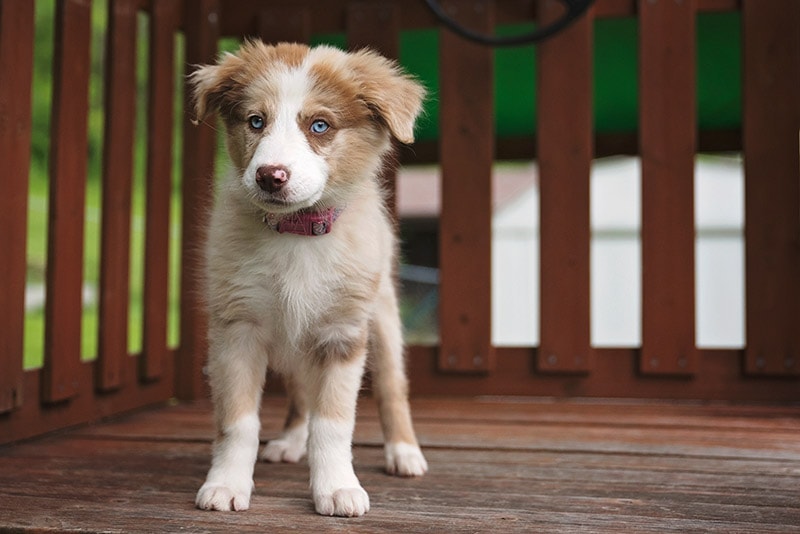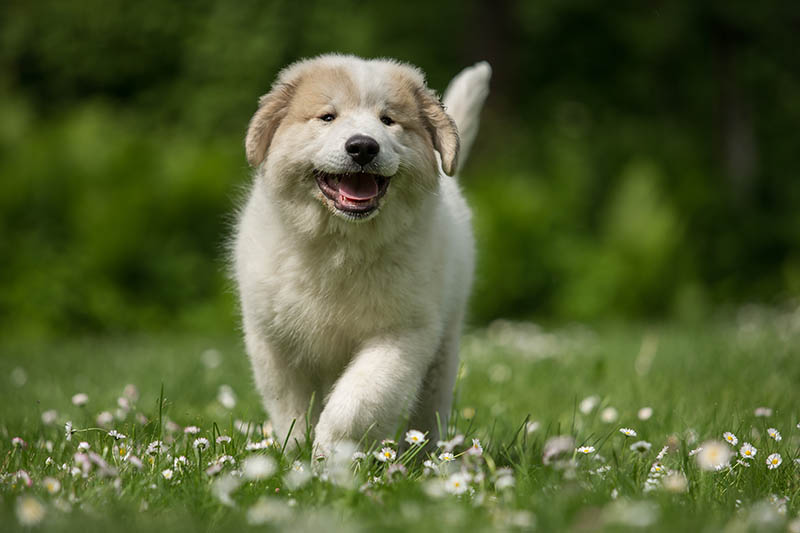Do Puppy Eyes Change Color? Fascinating Facts & FAQ

Updated on

The enchanting gaze of a puppy is a heartwarming sight that captures the hearts of dog lovers worldwide. Those big, soulful eyes, have a unique charm all their own.
But what many puppy owners wonder is whether the eyes of these adorable young canines are set in stone or not. Well, in most cases, a puppy’s eyes can change color as they grow older because the eyes of newborn puppies are not fully developed at birth and take several weeks to mature!
In this article, we explore the intriguing phenomenon of puppy eyes changing color!
Is It Normal for My Pup’s Eyes to Change?
Yes, it is entirely normal for a puppy’s eyes to change as they grow and mature! Most puppies are born with bluish eyes, but over time, their eye color may undergo a transformation.
This change is typically due to the development and maturation of pigments in the iris and is influenced by genetic factors. While this phenomenon can vary from one puppy to another, it’s a common occurrence, and the final eye color is usually established by the time the puppy is a few months old.

What Causes Puppies’ Eye Color to Change?
Puppies’ eyes change color as a result of their genetic make up and developmental changes. When puppies are born, they often have blue eyes due to the absence of melanin, the pigment responsible for eye color. Over time, as the puppy matures, the melanin-producing cells in the iris gradually become more active, leading to a shift in eye color.
Genetics also play a significant role in determining a puppy’s eventual eye color. The eye color of a puppy’s parents and ancestors can influence the outcome, as certain genes are responsible for producing different amounts of pigment in the iris.
It’s essential to note that not all puppies’ eyes will change color in an obvious way, and this change can even go unnoticed.
What Determines My Dog’s Eye Color?
A dog’s eye color is primarily determined by genetics and the presence of specific pigments in the iris. The amount and type of melanin, a pigment that ranges from brown to black, in the iris influence eye color.
In general, a dog with a higher concentration of melanin will have darker eyes, such as brown or black, while those with less melanin will have lighter-colored eyes, like blue or green. The specific combination of genes inherited from the dog’s parents determines the potential range of eye colors for that individual dog.
It’s essential to recognize that genetics play a significant role, but other factors like certain medical conditions can cause your dog’s eyes to change color, in which case, an urgent trip to the vet is vital.

When Will My Pup’s Eye Color Change?
A puppy’s eye color typically begins to change at around 6 to 8 weeks of age and continues to evolve over the following weeks. As the puppy grows, the melanocytes of the eye mature, leading to the shift in eye color. The specific timing and extent of this change can vary between individual puppies, influenced by their unique developmental pace.
Do All Puppies’ Eyes Change Color?
No, not all puppies’ eyes change color. While it’s common for puppies to undergo a gradual transformation in eye color as they mature, some dogs will retain the same eye color they had as puppies throughout their lives.
Puppies born with brown or other non-blue eye colors will typically maintain those colors, although there can be subtle variations in shade as they grow. It’s essential to recognize that a dog’s unique eye color contributes to their individuality and charm.
The Mature Dog’s Eye Color
The mature eye color of a dog can vary widely, with possibilities ranging from shades of brown (including dark brown, light brown, and hazel) to gold, blue, or blue-green.
The final eye color is primarily determined by the amount and type of melanin present in the iris, a pigment responsible for the coloration of the eyes. Dogs with higher concentrations of melanin tend to have darker eyes, while those with lower concentrations will have lighter-colored eyes.

How Will I Know if My Dog’s Eyes Won’t Change Color Anymore?
You can typically expect that your dog’s eyes won’t change further when they reach around 10 to 12 weeks of age. For most dogs, this is the timeframe within which most dogs’ eye colors are established.
At this stage, the iris has undergone sufficient melanin development to solidify the mature eye color. If you notice any sudden or drastic alterations in your dog’s eye color after this stage, it’s advisable to consult a veterinarian to rule out any underlying health issues.
When Should I Be Concerned of My Pup’s Eye Change Color?
While gradual changes in a puppy’s eye color are normal and expected during their first few months of life, there are situations when you should be concerned about such changes. If one or both of your puppy’s eye color starts changing suddenly and rapidly after the age of 4 months or if you notice any other accompanying signs like redness, excessive tearing, squinting, or changes in their behavior, it’s a good idea to consult a veterinarian.
Sudden and drastic changes in eye color can sometimes be a sign of underlying health issues such as inflammation, infection, injury, or developmental anomalies. Timely veterinary attention is crucial in such cases to rule out any potential problems and ensure the well-being of your puppy’s eyes.such as inflammation, infection, injury, or immune-mediated problems. Timely veterinary attention is crucial in such cases to rule out any potential problems and ensure the well-being of your puppy’s eyes.
Additionally, if your puppy’s eye color continues to change beyond 6 months of age, or if they develop cloudiness or a milky appearance in the eyes, it could indicate a more serious issue. Cataracts, glaucoma, and other eye conditions can affect a dog’s eye color and overall eye health.
In such cases, seeking professional advice from a veterinarian or veterinary ophthalmologist is essential to determine the cause and take appropriate measures to preserve your pup’s vision and eye health.

Wrapping Up
Your puppy’s eyes changing color is a fascinating aspect of canine development. Understanding the underlying factors, such as genetics and the maturation of pigments in the iris, can offer valuable insights into this natural transformation.
While most puppies’ eye colors stabilize by the age of approximately 10 weeks, there’s a unique charm in knowing that each dog is an individual, and their eye color may exhibit subtle variations throughout their lifetime.
It’s important for puppy parents to be aware of normal changes and to seek veterinary attention if they notice sudden, dramatic shifts or other concerning eye health-related signs.
Whether your furry friend’s eyes remain a stunning blue, turn to deep brown, or take on a different hue, their gaze will forever be a testament to the remarkable journey of growth and companionship that defines the bond between humans and dogs!
Featured Image Credit: Ivanova N, Shutterstock












